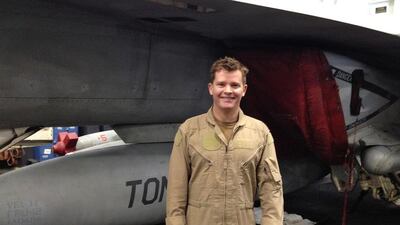ABOARD THE USS GEORGE HW BUSH // A US naval pilot carrying out strikes on ISIL has told The National that avoiding civilian casualties is the "highest of priorities" for him and his colleagues.The officer, who is currently deployed on the USS George HW Bush aircraft carrier in the Arabian Gulf, said that although all targets are "heavily vetted" by the US-led anti-ISIL coalition, responsibility for avoiding civilian casualties also lies with the pilots carrying out the strikes."The onus for everything that you do is always down to you as the aviator that's out there in the aircraft," said the F/A-18E pilot who did not want to be named for fear of ending up on an ISIL hit list."Our aircraft have … sensors that can basically see the ground" and "we're in constant communications with various agencies out there, both at the tactical control level, as well as directly on the ground".The United States has faced growing criticism in recent weeks following high numbers of civilian casualties in suspected American and US-led coalition air strikes on extremists in Iraq and Syria.On Saturday, the US-led coalition confirmed carrying out a March 17 strike on an ISIL-held district of west Mosul where residents and officials say as many as 200 civilians may have been killed. Earlier in the day, Iraqi authorities had announced a temporary halt to the offensive to retake western areas of the city – apparently prompted by the incident in Mosul Al Jadida district.The United Nations said on Tuesday that at least 307 civilians had been killed in the Mosul campaign between February 17 and March 22 – a toll that could exceed 400 if killings reported since then are confirmed.__________________________________
Watch American warplanes taking off and landing on the
USS George HW Bush
during training for ISIL strikes
__________________________________
The
USS George HW Bush
began launching air strikes on ISIL positions from the Arabian Gulf last week, the Bahrain-based US Naval Forces Central Command said on Friday. The commander of the carrier strike group, Rear Admiral Kenneth Whitesell, said Mosul would be the first “target area” for the raids, followed by locations in northern Syria, including Raqqa, ISIL’s last remaining stronghold.
The F/A-18E pilot described his mindset when heading out on missions targeting the extremist group.
“I think everybody in the back of their mind, I don’t know if fear is the right word, but definitely healthy respect for the scenario out there and we certainly talk [through] all of the contingencies that could happen,” said the officer, who flies solo during strike missions.
“I can tell you that the enemy we know is very real and … you know we’ve all seen the news and what they’re capable of, and I think the pilots that are [taking part] in this mission certainly have no doubt, there’s no doubt in terms of what they’re facing out there.”
In January 2015, Jordanian air force pilot Maaz Al Kassasbeh, 26, was burnt alive by ISIL militants after his F-16 jet crashed over northern Syria. The first lieutenant was taking part in a coalition mission against the extremist group at the time.
Shortly after,
The National
that when pilots are downed behind enemy lines, their chances of evading capture and being rescued begin to diminish rapidly after an hour – what combat search and rescue veterans call the “golden hour”.
The US naval pilot said he approaches strike missions against ISIL by “compartmentalising the flight” and “focusing on what’s important at that time”.
“In terms of the things you don’t want, obviously, any sort of in-flight emergencies, or things that are caused by [potential] fires from the ground … [but] you’re not really focusing on that, you’re just planning for those contingencies,” he added.
The
USS George HW Bush
has played a significant role in the coalition fight against ISIL, launching the first American air strikes on the group in August 2014 – shortly after ISIL seized large areas of Iraq, including Mosul.
Before sailing to the Arabian Gulf via the Suez Canal and Bab Al Mandeb strait this month, the ship spent nearly three weeks in the eastern Mediterranean. From there it launched about 220 air strikes on ISIL, dropping over 400,000 pounds of bombs, according to Admiral Whitesell.
lmackenzie@thenational.ae
* With additional reporting by Reuters and Agence France-Presse

